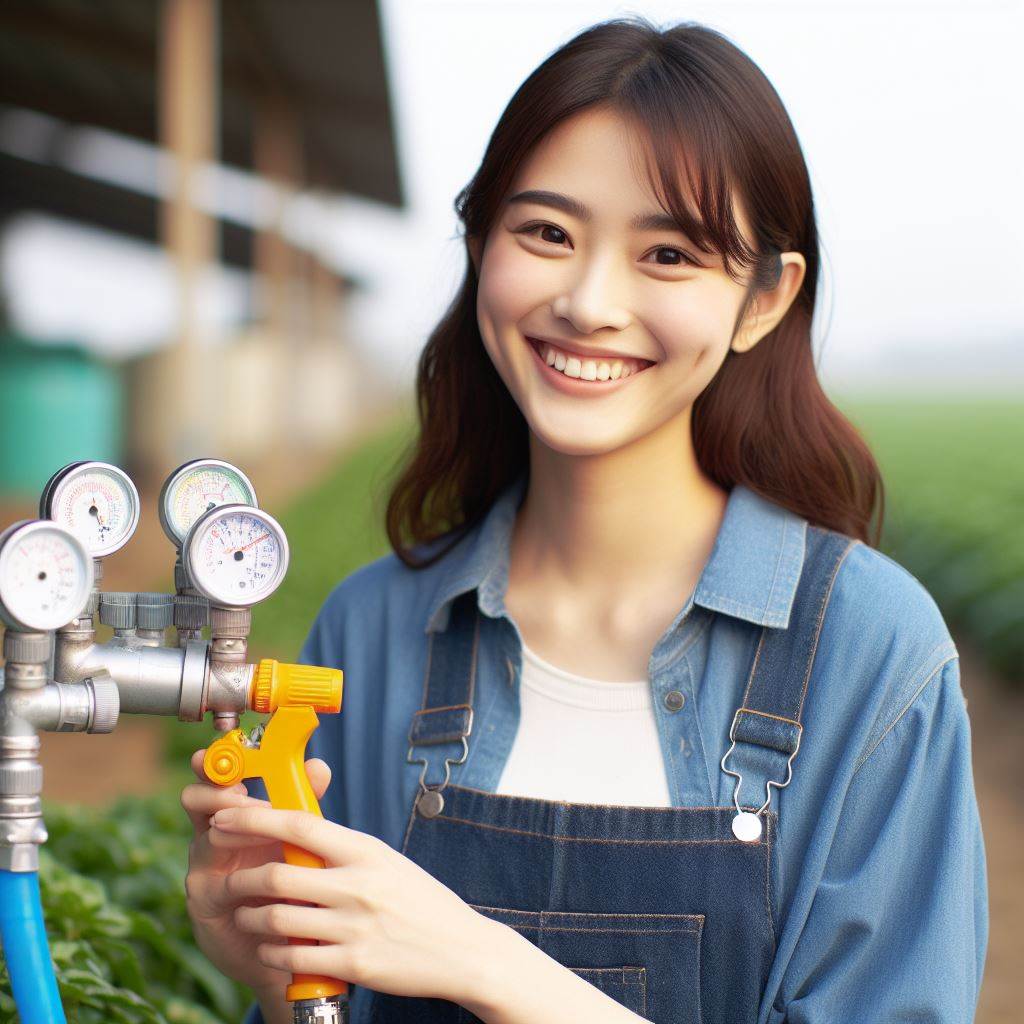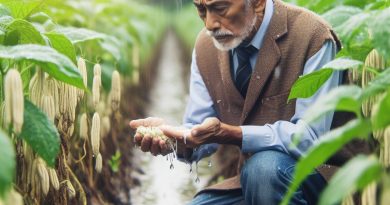Agri-Water Efficiency: Tools and Techniques
Last Updated on February 15, 2024
Introduction
Water scarcity and the growing demand for food necessitate efficient water usage in agriculture.
Agri-water efficiency focuses on achieving higher crop yields with minimal water consumption, ensuring the long-term viability of farming practices.
By optimizing water management, farmers can mitigate the impact of water scarcity, reduce production costs, and preserve natural resources.
The importance of agri-water efficiency extends beyond individual farms; it influences global food security and environmental sustainability.
Embracing innovative tools and techniques allows farmers to enhance water-use efficiency, such as precision irrigation systems, soil moisture sensors, and drought-resistant crop varieties.
This section delves into these strategies, providing valuable insights for farmers, policymakers, and stakeholders seeking to improve water management practices in agriculture.
Assessing Water Needs
Using crop water requirement models
Crop water requirement models are valuable tools for estimating the amount of water needed by crops.
These models take into account factors such as crop type, growth stage, and environmental conditions to determine water needs accurately.
By utilizing these models, farmers can optimize their irrigation practices and ensure efficient water usage.
Monitoring soil moisture levels
Monitoring soil moisture levels is essential to assess water needs accurately.
This can be done using various techniques such as soil moisture sensors or tensiometers.
By regularly measuring soil moisture, farmers can determine if irrigation is necessary and avoid over or under-watering, leading to better water efficiency.
Consideration of weather data
Weather conditions directly influence crop water needs. Incorporating weather data, such as temperature, humidity, and precipitation, into water assessment strategies is crucial.
By monitoring weather patterns, farmers can adjust irrigation schedules accordingly, preventing water waste and maximizing crop health.
Water balance calculations
Water balance calculations are comprehensive assessments of water inputs and outputs in a specific area.
This involves measuring irrigation water inputs, rainfall, surface runoff, and evapotranspiration to determine water requirements accurately.
By conducting water balance calculations, farmers can identify areas of inefficiency and implement targeted solutions to optimize water use.
In summary, assessing water needs in agricultural practices is essential for achieving water efficiency.
By utilizing crop water requirement models, monitoring soil moisture levels, considering weather data, and conducting water balance calculations, farmers can optimize irrigation practices and ensure sustainable water usage.
These tools and techniques play a crucial role in enhancing agricultural water efficiency.
Benefits of Utilizing these Tools and Techniques
- Accurate estimation of water needs
- Optimization of irrigation practices
- Prevention of water waste
- Maximization of crop health and productivity
- Identification of areas of inefficiency and targeted solutions
Points to Remember
- Regularly monitor and adjust irrigation practices based on crop water requirement models.
- Use soil moisture sensors or tensiometers to ensure proper irrigation and avoid water waste.
- Incorporate weather data into water assessment strategies for efficient irrigation scheduling.
- Conduct water balance calculations to identify inefficiencies and implement targeted solutions.
By following these strategies, farmers can make significant strides in achieving agricultural water efficiency and sustainability.
Read: Climate Impact on Crop Yields
Efficient Irrigation Systems
Introduction to different irrigation methods (e.g., sprinkler, drip, pivot)
Sprinkler Irrigation
- Utilizes overhead sprinklers to distribute water evenly over the cultivated area.
- Suitable for a wide range of crops and terrains, providing efficient coverage.
- However, subject to high water loss due to evaporation and wind drift.
Drip Irrigation
- Delivers water directly to plant roots through a network of tubes and emitters.
- Minimizes water waste by targeting the root zone effectively and reducing evaporation.
- Ideal for water-scarce regions, offers water and nutrient supply control.
- Requires careful maintenance to prevent clogging and ensure consistent water distribution.
Pivot Irrigation
- Circular, rotating sprinklers on a pivoting system deliver water over large areas.
- Provides uniform coverage with minimal water loss, suitable for large-scale farming.
- High initial investment and energy requirement for pumping water are potential drawbacks.
- Suitable for crops that can withstand overhead watering.
Benefits and drawbacks of each system
Sprinkler Irrigation
Benefits:
- Suitable for various crops and terrains.
- Provides efficient coverage.
Drawbacks:
- High water waste due to evaporation and wind drift.
- Not recommended for water-sensitive crops.
Drip Irrigation
Benefits:
- Minimizes water waste and evaporation.
- Ideal for water-scarce regions.
Drawbacks:
- Requires regular maintenance to prevent clogging.
- Higher initial investment compared to other methods.
Pivot Irrigation
Benefits:
- Uniform coverage with minimal water loss.
- Suitable for large-scale farming.
Drawbacks:
- High initial investment and energy requirement.
- Not suitable for water-sensitive or easily damaged crops.
Case studies of successful implementations
California’s Central Valley
- Sprinkler irrigation widely used due to diverse crops and large-scale farming.
- Efficient coverage achieved through proper system design and maintenance.
- Crop yield increased while water consumption reduced compared to flood irrigation.
Israel’s Negev Desert
- Drip irrigation utilized to overcome water scarcity and arid conditions.
- Precise control over water and nutrient supply significantly improved crop productivity.
- Reduced water usage by up to 50% compared to traditional flood irrigation.
Australia’s Murray-Darling Basin
- Pivot irrigation chosen to irrigate vast agricultural areas with limited water resources.
- Efficient water distribution achieved by optimizing system design and crop selection.
- Improved water efficiency contributed to sustainable agriculture and reduced environmental impacts.
Generally, efficient irrigation systems play a crucial role in optimizing water usage and maximizing crop productivity.
The choice of irrigation method depends on factors such as crop type, terrain, and water availability.
Sprinkler irrigation offers versatility, while drip irrigation excels in water conservation.
Pivot irrigation suits large-scale farming but requires substantial initial investment.
Successful case studies demonstrate the benefits of implementing these systems, emphasizing the importance of careful system design, proper maintenance, and considering specific regional conditions to achieve sustainable and efficient agri-water usage.
Read: Managing Farms in Extreme Weather
Precision Irrigation Management
Implementing Soil Moisture Sensors
Implementing soil moisture sensors is a crucial step towards improving agri-water efficiency.
- Soil moisture sensors provide real-time data on the moisture content in the soil.
- This data helps farmers make informed decisions about when and how much to irrigate.
- By precisely measuring soil moisture, farmers can avoid over or under-irrigation.
- Over-irrigation can lead to water wastage and leaching of nutrients, causing environmental damage.
- Under-irrigation can result in reduced crop yield and quality.
- Soil moisture sensors ensure optimal soil moisture levels, promoting healthy plant growth.
Utilizing Automated Irrigation Scheduling
Automated irrigation scheduling is another effective tool for enhancing agri-water efficiency.
- Using weather data and crop-specific information, automated systems determine irrigation needs.
- They calculate the precise amount and timing of irrigation required for optimal crop growth.
- Farmers can program these systems to operate automatically, reducing manual intervention.
- Automated irrigation scheduling helps minimize water wastage and reduces labor costs.
- It ensures that crops receive water when they need it the most, improving yield and quality.
- Furthermore, these systems can be remotely monitored and controlled, increasing convenience.
Integration of Real-Time Data for Irrigation Decisions
The integration of real-time data into irrigation decisions revolutionizes agri-water efficiency.
- Real-time data on weather, soil moisture, and crop conditions enables precise irrigation planning.
- Farmers can access this information through mobile applications or web-based platforms.
- By analyzing the data, farmers can make informed decisions to optimize irrigation schedules.
- Real-time data allows for timely adjustments in irrigation to respond to changing conditions.
- This integration enhances water efficiency by avoiding over or under-irrigation.
- It maximizes crop productivity and minimizes water and energy wastage.
In fact, precision irrigation management is key to enhancing agri-water efficiency.
Implementing soil moisture sensors, utilizing automated irrigation scheduling, and integrating real-time data for irrigation decisions are powerful techniques.
By adopting these tools, farmers can optimize water usage, improve crop yield, and protect the environment.
Read: Agroforestry: A Climate Smart Approach

Water Conservation Practices
Crop Selection and Water Demand
Crop selection plays a crucial role in optimizing water efficiency in agricultural practices.
Farmers must choose crops that require less water per unit of yield.
To achieve this, farmers can use advanced techniques such as precision irrigation and hydroponics.
Using drought-tolerant crop varieties can also significantly reduce water demand and improve overall water efficiency.
Conservation Tillage Techniques
Conservation tillage is an important practice that farmers can adopt to conserve water.
It involves minimizing soil disturbance during planting and cultivation.
By reducing tillage, farmers can enhance water infiltration and reduce evaporation.
This helps to maintain soil moisture and minimize water loss.
Adopting conservation tillage practices also promotes soil health and reduces erosion, leading to more sustainable farming systems.
Mulching and Cover Cropping
Mulching and cover cropping are effective methods to conserve water in agriculture.
Also, mulching involves covering the soil surface around plants with organic materials like straw or plastic.
This helps to reduce evaporation, maintain soil moisture, and control weed growth.
Cover cropping refers to the growth of specific crops during fallow periods or between main crop seasons.
The cover crops help to enhance soil water content, reduce erosion, and promote nutrient cycling.
Water Recycling and Reusing
Water recycling and reusing practices are crucial for sustainable water management in agriculture.
Farmers can collect and treat runoff water, allowing it to be reused for irrigation purposes.
This reduces dependence on freshwater sources and contributes to overall water conservation.
Additionally, treated wastewater from domestic or industrial sources can be used in irrigation systems, ensuring efficient water utilization.
Investing in proper infrastructure and technologies for water recycling is essential to maximize water conservation in agricultural operations.
In essence, adopting water conservation practices is vital for sustainable agriculture.
Crop selection based on water demand, conservation tillage techniques, mulching, cover cropping, and water recycling are effective methods to improve water efficiency.
By implementing these techniques, farmers can reduce water consumption, maintain soil moisture, and promote overall environmental sustainability.
It is important for farmers and policymakers to prioritize the adoption of these practices to ensure the long-term availability of water resources for agricultural production.
Read: Future Foods: Climate-Resilient Crops
Innovative Technologies for Agri-Water Efficiency
Sensor-based irrigation systems
- Sensor-based irrigation systems offer precise control over water usage.
- These systems use sensors to detect moisture levels in the soil.
- The sensors provide real-time data, allowing farmers to optimize irrigation schedules.
- This technology reduces water waste and ensures plants receive the right amount of water.
- Farmers can also monitor and adjust irrigation remotely through smartphone applications.
Remote monitoring and control
- Remote monitoring and control systems enable farmers to manage water usage from a distance.
- They use wireless sensor networks to collect data on soil moisture, temperature, and other factors.
- Farmers can access this data using mobile devices or computers.
- With remote control capabilities, farmers can adjust irrigation systems and water delivery as needed.
- This technology allows for more efficient use of water resources, reducing waste and costs.
Use of drones for crop water management
- Drones equipped with imaging sensors provide valuable insights into crop health and water needs.
- These aerial devices capture high-resolution images, detecting areas of water stress in crops.
- Farmers can identify specific regions that require additional irrigation or crop treatment.
- Drones also help identify leaks or broken pipes in irrigation systems, promoting efficient water usage.
- By targeting water application, farmers can mitigate water loss and improve overall crop yield.
Adoption of smart agriculture technologies
- Smart agriculture technologies integrate sensors, data analytics, and automation for efficient water management.
- These technologies collect and analyze data from various sources, such as weather stations and soil sensors.
- They provide accurate information on current and future water needs for crops.
- Farmers can make informed decisions and optimize irrigation schedules based on real-time data.
- By adopting smart technologies, farmers can minimize water usage, reduce costs, and enhance productivity.
Therefore, innovative technologies have revolutionized agriculture by enhancing water efficiency.
Sensor-based irrigation systems, remote monitoring and control, drones for crop water management,
and smart agriculture technologies are key tools for optimizing water usage and maximizing crop yield.
By embracing these technologies, farmers can ensure sustainable agriculture practices and contribute to water conservation.
Government Policies and Incentives
Agricultural water efficiency is crucial for sustainable farming practices.
Governments around the world have recognized the importance of water conservation and have implemented various policies and incentives to encourage farmers to adopt water-saving techniques.
Supportive regulations promoting water-efficient practices
Governments play a vital role in setting up regulations and standards that promote water-efficient practices in agriculture.
These regulations provide guidelines and requirements for farmers to follow to ensure water conservation.
For example, governments may limit the amount of water farmers can extract from rivers or groundwater sources, thus encouraging them to use water more efficiently.
Furthermore, supportive regulations may also impose restrictions on water-wasting practices such as excessive irrigation or inefficient water distribution systems.
By enforcing these regulations, governments not only protect water resources but also encourage farmers to adopt more sustainable water practices.
Financial incentives for farmers investing in water-saving technologies
Recognizing the financial burden of implementing water-efficient technologies, governments provide various financial incentives to support farmers.
These incentives can include grants, subsidies, or tax benefits for farmers who invest in water-saving technologies such as efficient irrigation systems or precision farming equipment.
Financial incentives help offset the initial costs of adopting these technologies, making them more accessible to farmers.
Additionally, these incentives encourage farmers to prioritize water efficiency as they can see direct financial benefits from their investments.
Examples of successful government initiatives
Several countries have introduced successful government initiatives to promote agri-water efficiency.
One prominent example is Australia’s Murray-Darling Basin Plan. This plan focuses on improving water management in the Murray-Darling Basin, one of Australia’s largest and most important agricultural regions.
The Murray-Darling Basin Plan implements a cap on water extraction, ensuring a sustainable balance between irrigation and environmental needs.
It also facilitates water trading, allowing farmers to buy and sell water entitlements based on their needs and availability.
Another successful example is Israel’s National Water Efficiency Program.
Israel, a country known for its limited water resources, has implemented comprehensive measures to maximize agri-water efficiency.
The program includes initiatives such as promoting drip irrigation, improving monitoring systems, and providing financial incentives to farmers who adopt efficient irrigation practices.
Israel’s water efficiency initiatives have not only enabled the country to be self-sufficient in food production but also positioned it as a global leader in agricultural water management.
In review, governments play a crucial role in promoting agri-water efficiency through supportive regulations and financial incentives.
By implementing these measures, governments can ensure sustainable farming practices while protecting water resources for future generations.
Conclusion
Recap of key points discussed
Throughout this blog section, we delved into the importance of agri-water efficiency and various tools and techniques that can aid in sustainable water management for farmers.
We explored the significance of water scarcity and the need for efficient water usage in agriculture.
The future of agri-water efficiency
As the world population continues to grow, the demand for food will increase, putting further pressure on water resources.
Thus, the future of agri-water efficiency becomes crucial in ensuring sustainable food production.
Embracing innovative technologies and practices will be crucial.
Encouragement for farmers to adopt tools and techniques for sustainable water management
It is essential for farmers to recognize the significance of water conservation and adopt appropriate tools and techniques to enhance agri-water efficiency.
Through the use of smart irrigation systems, precision farming, soil moisture sensors, and proper crop selection, farmers can reduce water wastage and improve productivity.
Overall, agri-water efficiency is vital for the sustainable management of water resources and the long-term viability of agriculture.
By implementing appropriate tools and techniques, farmers can play a significant role in conserving water, optimizing yields, and contributing to global food security.
It is imperative that farmers embrace these practices and work towards a more sustainable and water-efficient future.


